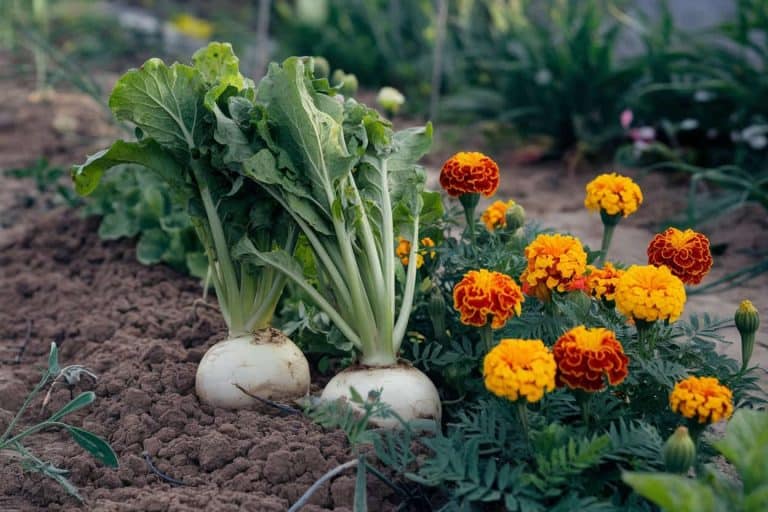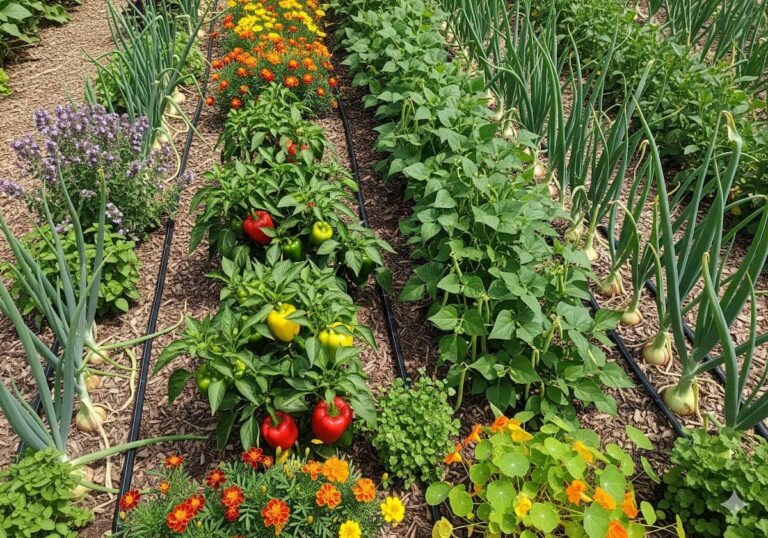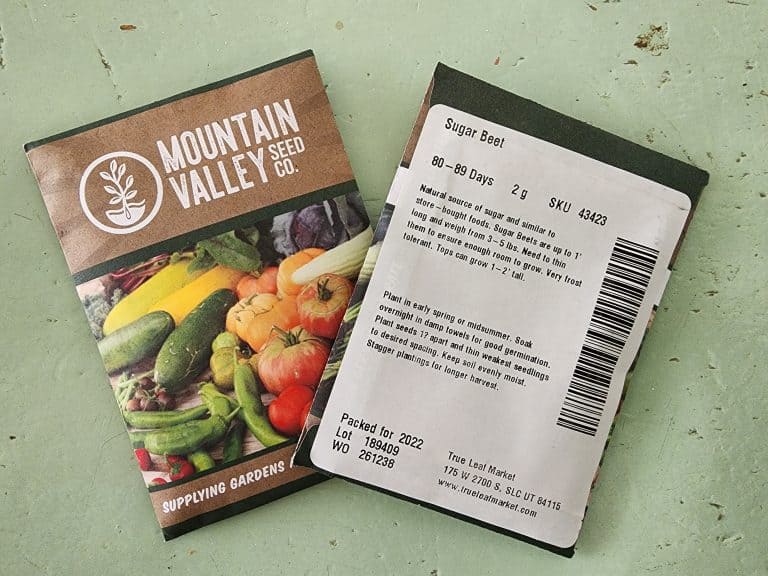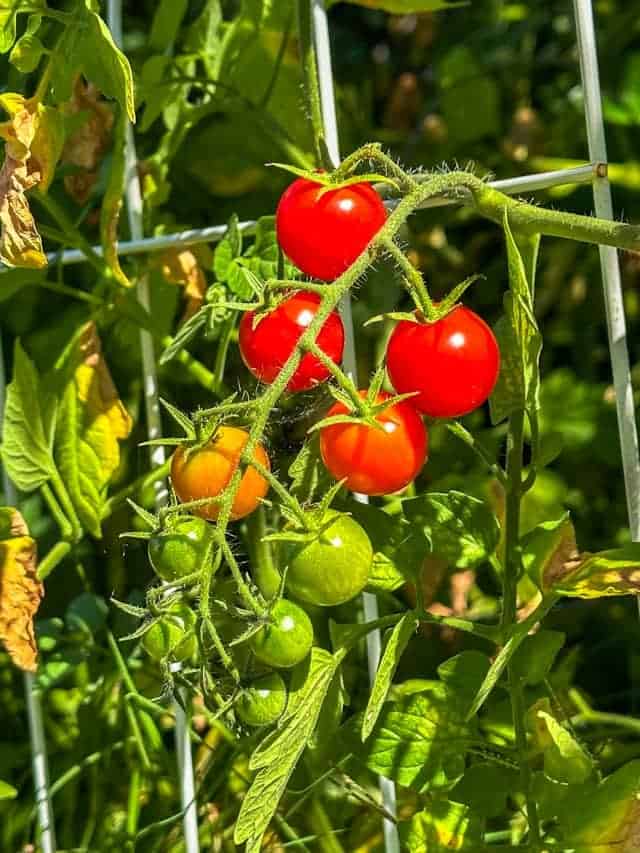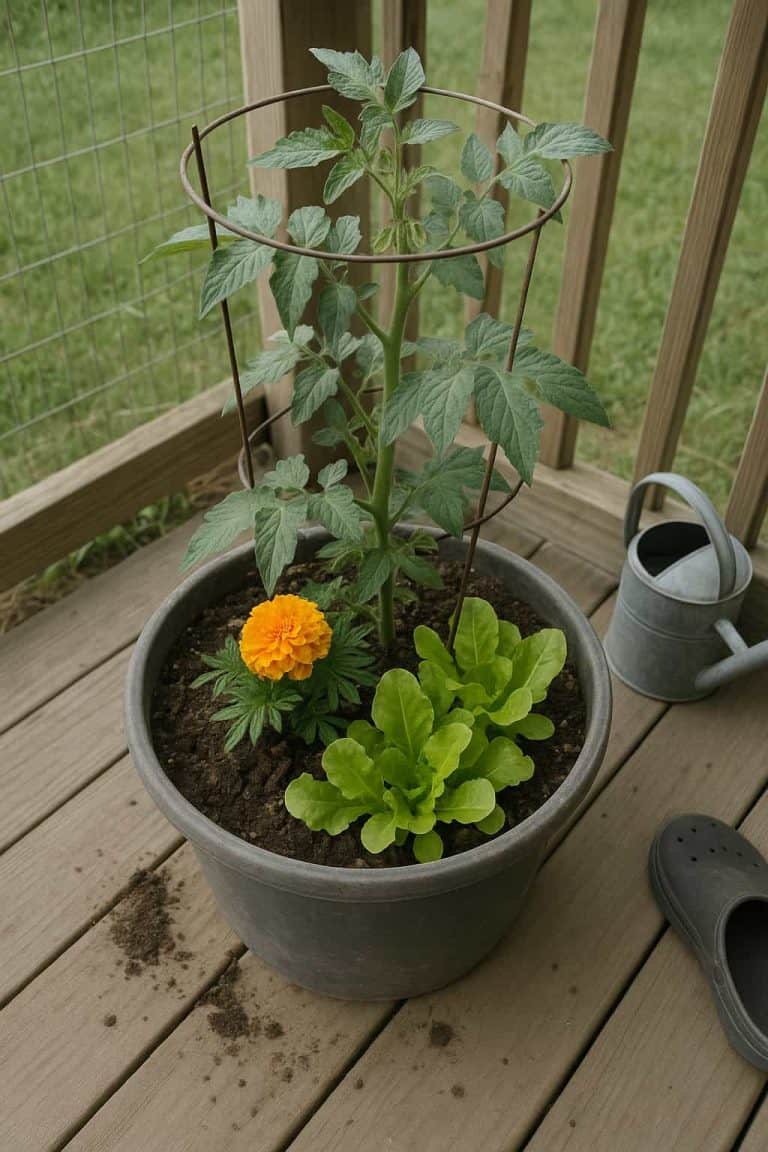This post may contain affiliate links, which means I will earn a commission at no cost to you if you make a purchase using these links. I only recommend products that I either would or have used myself or for my family.
Growing your own sweet potato slips is easier than you might think! Did you know that sweet potatoes are grown from slips instead of seed potatoes like russet or red potatoes? True story! You don't order “sweet potato seeds”, and you don't plant a whole sweet potato and hope it grows. (Well, in some climates you may be able to do this, but you'll have much better luck if you start with slips in the majority of locations.)

A sweet potato “slip” is simply just a sprout from a sweet potato that has been rooted. I know that seems really basic, but I'm not about making things harder than they need to be around here! It's fun and easy to grow your own slips. Let me give you a little background, then dive in and show you two different ways to grow sweet potato slips and what in the world you do with them after they start growing.
How are sweet potatoes different than regular potatoes?
Regular potatoes and sweet potatoes while both “potatoes” are actually quite different. Sweet potatoes are a member of the morning glory and bindweed family. Honestly, it's a miracle my husband “lets” me grow them since bindweed is one of our mortal enemies in the fields, lol. Joking aside, sweet potatoes are considered root vegetables or root tubers.
Regular potatoes (like russets or reds) are members of the nightshade family (Like tomatoes) and are stem tubers. There is a bit of disagreement about which type of potato is healthier based on nutrient content, but I will let you decide what you think!
Why grow your own sweet potato slips?
You can definitely order sweet potato slips from a variety of garden shops. (both online and in-person) One of the biggest reasons I like to grow my own is the cost! Purchased sweet potato slips can cost anywhere from twenty to forty-plus dollars plus shipping. That usually gets you 12-25 slips.
A second reason that I like to grow my own slips is that a full order of slips from an online shop is too many plants for my family. Instead of trying to find someone to share the order with, it's easier just to grow the amount I need.
Growing your sweet potato slips is fun! If you don't enjoy gardening or growing things, you may disagree with that statement, lol, but I think it is fun and enjoyable. When my son gets older it will also be a great way to teach him about how different plants grow.
The last reason I enjoy growing my own is that I can guarantee their health. The slips that I grow are vigorous, healthy, and in great shape to go in the ground! (or should be, lol) When you receive slips in the mail, they may be stressed and not quite as robust after having been shipped which unfortunately means you may have some loss.
Where do you get sweet potatoes to start slips?
If you want to start your own sweet potato slips, you're going to need a sweet potato. (Or 2, or 5) If you grew your own sweet potatoes last season, then saving a few through the winter is the perfect way to get the potatoes you need to grow slips.
You can also purchase sweet potatoes at the grocery store. When purchasing specifically for growing slips, try to buy organic potatoes. Sometimes potatoes are treated with a sprouting inhibitor to keep them from growing sprouts in your cupboard. Organic sweet potatoes are less likely to have this inhibitor applied.
The other place I always check is my own cupboard! I'm sure I'm not the only one who buys produce with good intentions and finds it later all sprouted. Fun story, I actually thought that I needed to go buy a few sweet potatoes so I could get them ready to grow slips. I reminded myself to check the cupboard and sure enough… 3 sweet potatoes with teeny tiny sprouts already. Just make sure your sweet potatoes aren't mushy or moldy, and you'll be good to go!
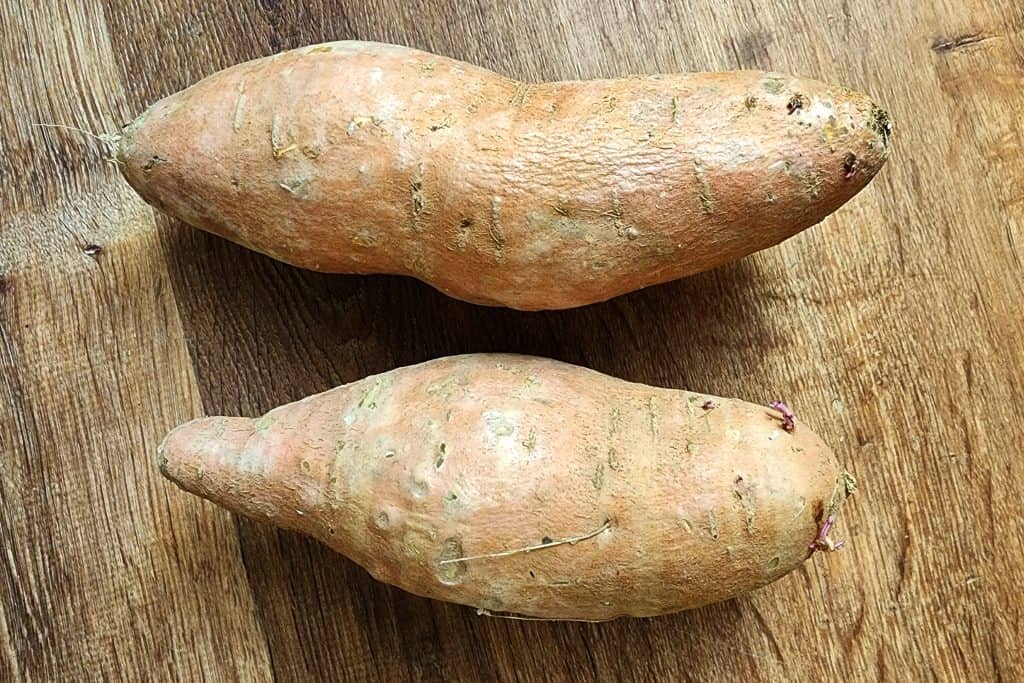
When should you start sweet potato slips?
Sweet potato slips shouldn't be planted until your soil temperature reaches around 65 °F. For me, that is about 2 weeks or so after my average last frost or about May 20th. My property has a bit of its own microclimate, so I either measure my soil temperature or just wait another week before planting if it has been a colder Spring.
Sweet potato slips take around 6-8 weeks to sprout, grow, and root. Using my planting date of May 20th, and counting backward 8 weeks, I would start mine on March 25th. You could also just use your last frost date and count back 6 weeks to get the same date.
If you're excited and just can't wait to get something growing, it's ok if you start your slips sooner. Personally, I always add an extra week or two of time to my planning. I want to make sure I have time in case something goes wrong or they grow more slowly for some reason. We keep our house pretty cool in the winter (63-65 °F) so my plants tend to grow a bit slower
After you get them rooted (more info on that below), you can plant them in soil in pots and keep them indoors under lights or in a sunny spot until it gets close to planting time. You must harden them off though, before planting them outside.
How many slips do you need?
How many slips you need depends on how many sweet potatoes your family eats and if you have a proper storage area to keep them fresh during the cold months. If grown in appropriate growing conditions, you can expect around 4-5 plus potatoes per plant.
Now decide how many sweet potatoes you need in a week for your family. For the sake of simplicity, we'll say you need 5 sweet potatoes per week. Then decide how many weeks' worth you want to store. You can potentially store them for up to six months if stored properly. Six months is around 24 weeks. So you would need to plant 24 slips to get that many potatoes.
If you don't want to store them, preserve them (dehydrate, can, etc), or just simply don't have a proper place to store them, then only grow enough potatoes that you can eat in a couple of months.
How many sweet potatoes will you need to grow enough slips?
There are many factors that dictate how many slips each sweet potato can grow. Size of the potato, temperature, light, quality of potato, method of growing, and much more. I've heard of some people getting 20 or more per potato, but that has not been my experience. I usually plan for 5-10 slips per potato.
If you have calculated approximately how many sweet potato slips you will need to grow what you want for you and your family, divide that number of slips by the amount you expect to get from each potato you start. I like to err on the side of caution and just figure 5 slips per potato. If we use our example from above and you need 24 slips for your garden this year, then you will need to start 5 potatoes.
You will probably have more than you need, but having extra isn't a bad thing. Sometimes you lose a slip or two while getting them ready for the garden, you can give them away to friends, family, or neighbors, or you can start a sweet potato vine for a house plant. They have beautiful vining foliage and make lovely plants. (Although they can be a bit toxic to cats)
How to start sweet potato slips two simple ways
There are two simple methods of getting your sweet potatoes sprouted and growing slips: the water method and the soil method. There are pros and cons to each method, but keep reading to see which method might work best for you!
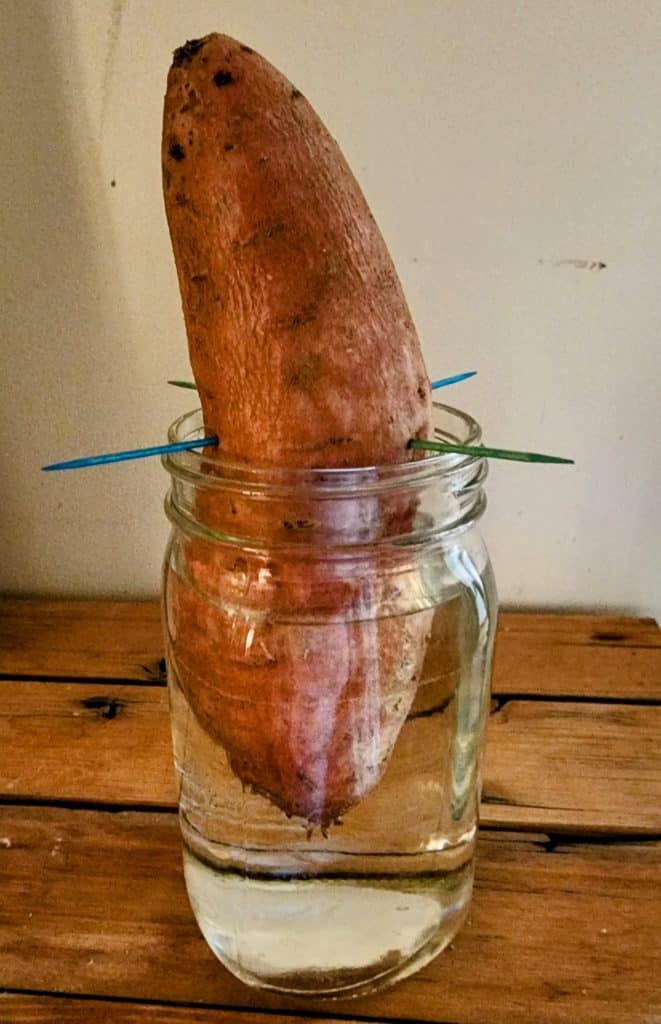
• Water Method
Supplies needed: Clean quart jar or other container of similar size, toothpicks or kebab sticks, water, a sweet potato
- Choose your sweet potatoes. Make sure they are not mushy, moldy, or otherwise compromised.
- Brush off any excess dirt if there is any.
- Find the root end of your potato.
- Place 3 or more toothpicks or kebab sticks into the middle of the sweet potato making sure to leave enough length to support the potato on the jar or other container.
- Fill the jar with water, leaving an inch or so of space at the top.
- Insert the sweet potato, root end first, into the jar of water until it rests on the toothpicks.
- Sit in a warm location with indirect sunlight.
- Change water weekly and refill as needed in between if you notice your water level has dropped an inch or more.
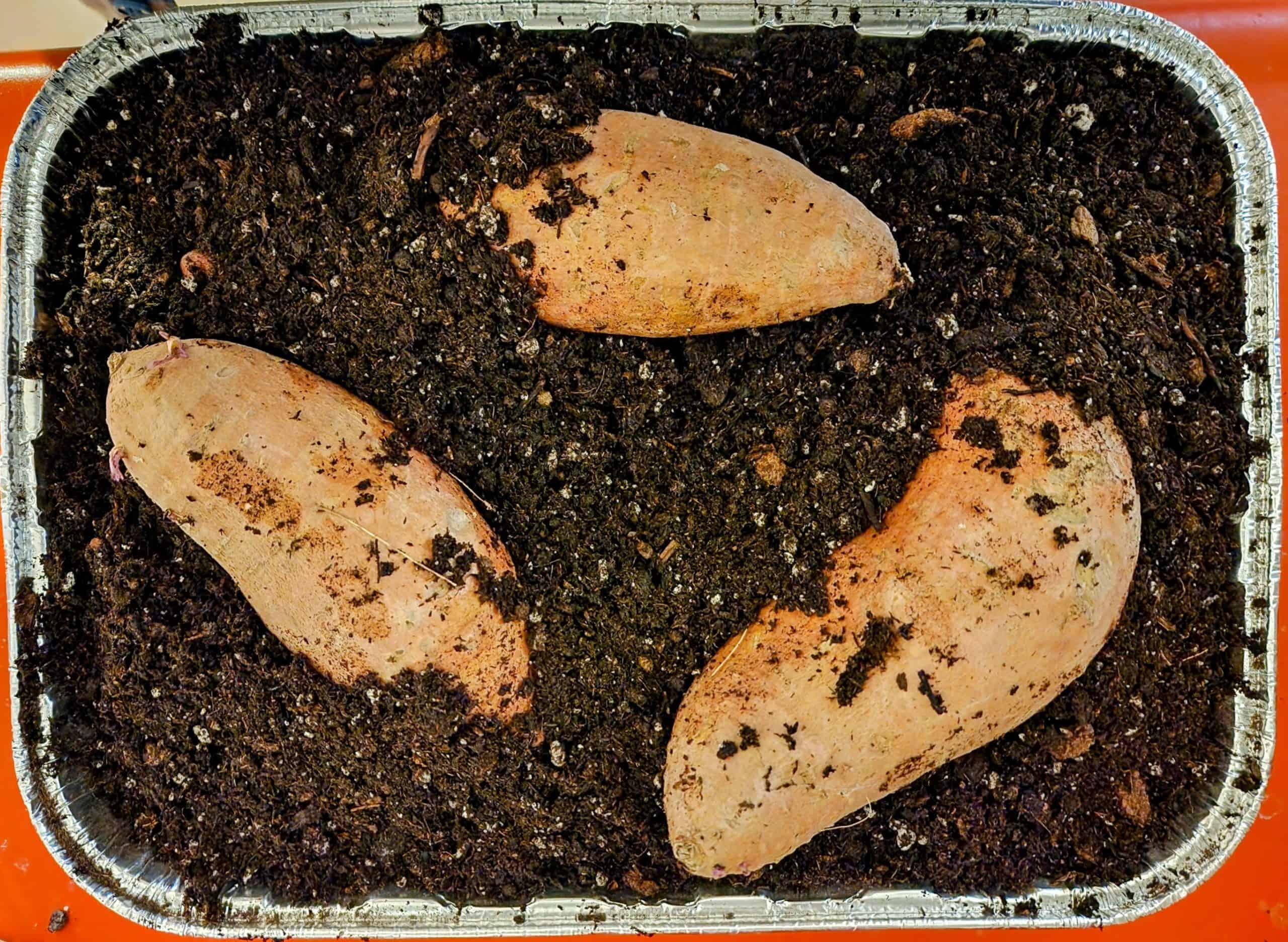
• Soil Method
Supplies needed: Shallow container that can hold 3 inches of soil, potting soil, water, sweet potatoes
- Choose your sweet potatoes. Make sure they are not mushy, moldy, or otherwise compromised.
- Find the root end of your potato(es).
- Fill your shallow container full of moist (not wet) soil
- Lay your potato(es) on their sides and cover them halfway with the soil. I also fully cover the root end, but that is optional.
- Sit in a warm location with indirect sunlight.
- If you live in a very dry climate as I do, you may also consider placing some type of clear cover over your container loosely to keep moisture in. (Be sure it is not touching the sweet potatoes and is not sealed tight… things need to breathe.)
- Patiently wait for your potatoes to sprout.
What to do once your sweet potato has sprouted?
No matter which method you used, you should soon have beautiful slips growing on your sweet potatoes. It's now time to get them ready to plant in the garden. Once your slips are 4-5 inches long, you can carefully either cut or snap them off from your potato. If your sweet potato is still in good shape (not mushy or rotten) you can leave it to keep making more sprouts.
Now that you have your slips you need to “root” them. Pinch off a couple of leaves from the bottom of the slip (make sure to leave a few towards the top), and place the stem in a cup of water. Do not submerge the entire slip, just the bottom half or a couple of inches of the stem. Keep an eye on the water and change it as needed or every few days to keep it fresh.
Place your cup of sprouts in a sunny warm location or under grow lights. You should see roots starting to form soon. In a week or two your slips should have several strong roots that are a few inches long. Once they reach this point your slips are ready to be planted.
If your weather and soil temperature is appropriate, you can plant your slips in the garden. I like to plant my rooted slips in small pots under grow lights indoors for a week or two to make sure they are growing strong.
Make sure to harden your plants off a bit before planting them in the garden. Hardening off simply means acclimating them to being outdoors in the sunlight and wind. I do this by sitting them outside for a few hours, increasing the time each day until they can spend a whole day outside without getting wilted or puny looking.
Will you try growing sweet potato slips this year?
Growing your own sweet potato slips can be a fun, inexpensive, and rewarding way to get the plants you need to try growing sweet potatoes in your garden this year. It's a great activity to do with your family or to get your hands in the dirt when it's still too chilly outside to garden


